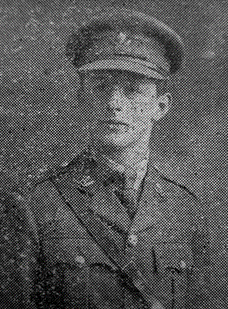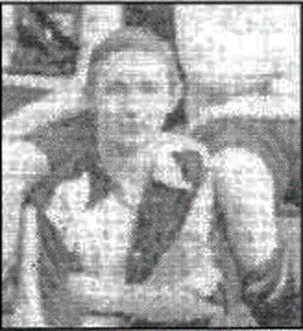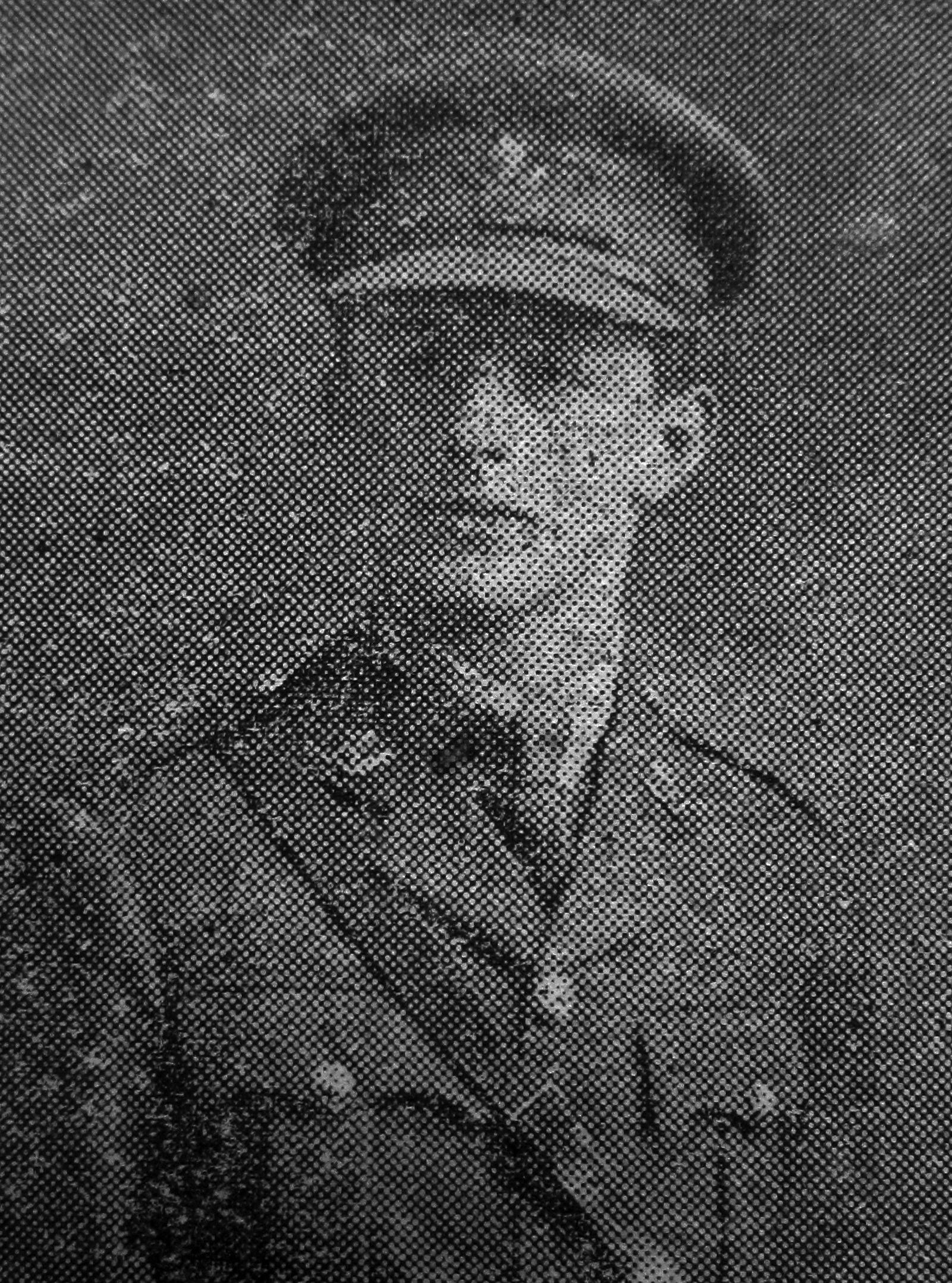Fact file:
Matriculated: 1914
Born: 16 August 1896
Died: 27 May 1918
Regiment: Worcestershire Regiment
Grave/Memorial: Soissons Memorial
Family background
b. 16 August 1896 at Cinderford, Gloucestershire, as the younger son of Henry George Gardner (1874–1921) and Charlotte Elizabeth Gardner (née Watkins) (1868–1962) (m. 1894). At the time of the 1901 Census the family was living at Lower High Street, East Dean, Gloucestershire (no servants); at the 1911 Census it was at 44, Barborough Road, Worcester (no servants); it then moved to “Coromandel”, Milton Road, Weston-super-Mare, Somerset; in 1916 it was living at 19, Alexandra Parade, Weston-super-Mare; and in 1922 Charlotte Elizabeth was living at “Hansworth”, 3, Albert Quadrant, Weston-super-Mare.
Parents and antecedents
Gardner’s father was the son of George Gardner (1843–1900) a sawyer of Huntley, Gloucestershire. Henry George became a Superintendant and then a District Manager with Pearl Assurance, Ltd. He was not well off.
Gardner’s mother was the daughter of John Watkins (1831–1908), a butcher, of Taynton, Gloucestershire.
Siblings and their families
Brother of:
(1) Percy Cecil Henry (1895–1974); married (1921) Gertrude Emma Talbot (1898–1985); at least one child;
(2) Gwendoline Victoria M. (1899–1985); married (1918) Harry Gibbons (1891–1952); two sons, one daughter.
Percy Cecil enlisted in the Somerset Light Infantry in November 1915 and was discharged in January 1919, becoming a Lance-Corporal. At the time of the 1911 Census he was an insurance clerk, and in 1939 he was a clerical officer with the Customs in Bristol.
Harry Gibbons was in 1911 a sorting clerk and telegrapher, and in 1939 he was a supervising officer (telegraph) with the General Post Office.
Education and professional life
Gardner attended the Royal Grammar School, Worcester, from 1909 to 1914, and on 29 September 1914 his father wrote to President Warren explaining that he was not well off but could make an allowance of £150 p.a. “which I note you suggest as the smallest sum available”. A keen amateur sportsman, he matriculated at Magdalen as a Demy in Mathematics on 13 October 1914. Although he had been exempted from Responsions because he had an Oxford Senior Local Certificate, he sat two Additional Responsions papers – Greek and Latin Prose in Trinity Term 1914 and the paper on the French Historian Alexis de Tocqeville in September 1914 – presumably to avoid having to sit the non-mathematical components of the First Public Examination. In Trinity Term 1915 he was awarded a 1st in Mathematics Moderations (Honours), and, subsequently, the Goldsmith Open Exhibition in Mathematics and Divinity. But at the end of that term he left without a degree.
War service
After leaving Oxford, Gardner, who was 5 foot 6 inches tall, attested on 3 December 1915. He was enrolled in the Army Reserve on the following day and on 7 December 1915 he wrote to President Warren, from whom he needed a reference, that he had spent 14 months in his School’s Officers’ Training Corps, had volunteered for the Army under Lord Derby’s scheme, and was now in charge of a Young Men’s Christian Association
tent with the Army Service Corps in Surrey. He was mobilized as a Private in the Somerset Light Infantry on 20 January 1916, spent 18/19 February 1916 in the Alderney Isolation Hospital with cerebro-spinal fever (spotted fever), remained in hospital for ten weeks, and was still on sick leave on 11 June 1916, when he wrote another letter to President Warren informing him that he wanted to apply for a commission. On 21 February 1916 he had been promoted Lance-Corporal; on 1 September 1916 he was sent to a Training (Reserve) Battalion as Acting Corporal even though he was still on sick leave; his Battalion Commanding Officer gave him permission to apply for a commission on 16 September 1916; and he finally submitted his application on 18 September 1916, when he was in the 45th Training (Reserve) Battalion at Swanage, Dorset. From 18 September to 11 November 1916 he was in No. 4 Company in Jellalabad Barracks, the Southern Command School of Instruction at Tidworth, on Salisbury Plain, where he was nominated for a commission on 4 November 1916. From 26 January to 3 February 1917 he was in the Military Hospital, Wareham, Dorset, suffering from influenza, before being attached to the 3rd (Regular) Battalion of the Worcestershire Regiment on 28 February 1917, and gazetted as a Temporary Second Lieutenant in the 1st (Regular) Battalion of the same Regiment on 3 April 1917 (London Gazette, no. 30,129, 12 June 1917, p. 5849). The 1st Battalion was part of the 24th Brigade in 8th Division, one of the four Divisions comprising IX Corps that was commanded from 1916 to 1918 by Lieutenant-General Sir Alexander Hamilton-Gordon (1859–1939).

Maurice Reginald George Gardner (c. 1917)
Photo courtesy of Magdalen College, Oxford; copied from Weston Mercury (Weston-super-Mare), no. 3,274
(19 October 1918), p. 5.
We do not know exactly when Gardner went to the front to join the 1st Battalion as its War Diary is sketchy and did not identify newly arriving officers in the early months of 1917. But given the above dates, it is very probable that he was one of the half dozen replacement officers who reported for duty in March 1917, after the Battalion had lost ten officers and 413 other ranks (ORs) killed, wounded or missing on 3 March during the capture of the important vantage point of Bouchavesne-Bergen, about three miles north of Péronne, and the ensuing advance on Moislains, on the Canal du Nord and two miles further eastwards. In the second half of March 1917, the Battalion was in the trenches nine miles south-west of Cambrai, between the hamlet of Peizière and the village of Heudicourt, and opposite Gouzeaucourt, where C.E. Hemmerde would be killed in action 18 months later. By May 1917, a peaceful time in that part of the Western Front, the Battalion had moved a mile or so eastwards, to trenches between the villages of Guyencourt and Villers-Guislains, i.e. roughly to the site of the modern A26 motorway, and with billets at Sorel-le-Grand, some six miles to the west. On 29 May 1917, the Battalion left the Cambrai sector of the front, route-marched c.35 miles south-westwards via Albert to Corbie, and entrained there for the Ypres Salient, arriving at Godeswaersvelde, near Steenvoorde and just south of the Franco-Belgian frontier, on about 1 June. It rested in billets near the village of Merris, six miles to the south, from 3 to 14 June, and then travelled via Ypres to trenches in the Hooge sector of the front, a few miles to the east. The Battalion then alternated between the trenches in this area and periods of rest in nearby camps until 7 July, when it was withdrawn to Steenbecque, roughly four miles south-west of Hazebrouck, and thence to an unidentifiable location nearby.
It was here, on 11 July 1917, when Gardner was in charge of a party of ORs who were being taught how to throw No. 5 Mills Bombs (hand grenades) on a bombing range, that one of the trainees, Private Taylor, tried to throw a grenade over the protective bank in front of the party. But he missed his aim and the grenade rolled back down, wounding Gardner in the right leg and injuring two other ORs, one of them seriously. Gardner was taken to the 39th General Hospital, British Expeditionary Force, where the splinter was removed from his leg on 12 July, and then admitted to the Red Cross Hospital, Le Touquet, on 17 July 1917. By 23 July 1917 he had been taken to the Horton War Hospital, Epsom, Surrey, where the wound healed slowly, causing Gardner to remain in hospital, where he did not make much progress until October. As a result, he did not take part in the Battles of Pilckem Ridge (31 July–2 August) and Langemarck (16–18 August) in which his Battalion, still part of the 24th Brigade in the 8th Division, was involved. The scars had still not firmed up properly by 7 December and the wound was still tender on 9 January 1918, when a Medical Board decided that Gardner was only capable of one month of General Service in England. But on 1 February 1918, when Gardner was stationed at Dovercourt, Essex, on attachment to the 5th (Reserve) Battalion of the Worcestershire Regiment, which was stationed at nearby Harwich throughout most of the war, arwichHH Hanother Medical Board finally decided that he was fit enough to return to France.
It seems probable that Gardner rejoined the 1st Battalion on 13 February, when it was on a four-day stint in the Westroosebeke (Westrozebeke) Sector of the Ypres Front, about nine miles north-east of Ypres and two miles north of Passchendaele. From 15 February until 22 March the Battalion was either in the trenches or resting and training in camp behind the lines, but on 22 March, the day after the start of Operation Michael, it and the rest of 8th Division marched southwards to St-Omer and were transported south-eastwards to the town of Nesle, c.14 miles south of Péronne on the Somme front, in order to help stem the German breakthrough. From Nesle, where it arrived on 23 March, the Battalion hastened northwards for six miles to Épénancourt, two miles west of the Canal du Somme, and there, with its right flank at the town of Pargny, a crossing-place on the Canal itself, it helped to push back the German attack from Épénancourt. But on 24 March the right flank of the 24th Brigade was forced back northwards to Licourt and then, on 25 March, westwards to the railway south of the village of Marchelipot. On 26 March Gardner’s Battalion, like the rest of the 8th Division, was forced back further to the north-west, to the village of Ablaincourt-Pressoir, which it held for a day until compelled to retire to the high ground west of the village of Vrély, about seven miles to the south-west.
After that the British retreat accelerated and over the next three days the 8th Division withdrew c.14 miles south-westwards via Caix, the town of Moreuil, the village of Rouvreuil, and Jumel, on the outskirts of Ailly-sur-Noye. On 30 March 1918, Gardner’s Battalion was ordered to retrace its steps and hold the ravine north of Moreuil, having lost 20 officers and 398 ORs killed, wounded or missing during the previous week, and on 1 April 1918 the remnants were helping to hold a line on the western edge of Moreuil, a mere ten miles south-east of the centre of Amiens. But on that day, the survivors were taken by bus 20 miles to Hangest-sur-Somme, ten miles north-west of Amiens, from where, on 12 April, they were transported by train to Querrien, roughly six miles north of Quimperlé on the Brittany Peninsula, where they trained for a week. On 19 April the Battalion was back at the front, holding the line at Villers-Bretonneux,. nine miles east of the strategically important centre of Amiens, together with the other remnants of the 8th Division, which had, since the start of Operation Michael, lost 250 officers and c.4,700 ORs and been compelled to reinforce itself with poorly trained 18-year-olds. The Battalion stayed at Villers-Bretonneux until 23 April, the day before J.P.F. Kennedy was killed in action on the opening day of the Second Battle of Villers-Bretonneux (24–27 April 1918, the first time that tanks had been used by two opposing armies) and the final phase of Operation Michael. Gardner’s Battalion spent the period from 23 April to 1 May 1918 in billets at Camon, an eastern suburb of Amiens, before marching via Guignecourt to Saleux, in the south-west suburbs of the city, where, together with the rest of IX Corps, it entrained.
Like the rest of battered IX Corps, Gardner’s Battalion was being transferred eastwards in order to rest and refit as part of the French 6th Army in that apparently quiet part of the Western Front which ran north-west for c.15 miles from Berméricourt, roughly six miles north of Reims (Rheims), to Bouconville-Vauclair near the eastern end of the east-west ridge that was known as the Chemin des Dames. This ran roughly parallel to and some ten to12 miles north of the River Aisne from the village of Vauxcéré in the west (just near the old German strong-point of the Fort de la Malmaison) to Corbeny in the east, and had been taken in September 1914 by the Germans at the end of the First Battle of the Aisne (cf. E.M.R. Stadler, who had seen action there at that time). But in April 1917, during the Second Battle of the Aisne (16 April–15 May 1917), part of the offensive that was master-minded by General Robert Nivelle (1856–1924), the French recaptured a two–three-mile-long stretch of the Chemin, at great cost to themselves (187,000 French casualties), and since then this sector of the front had seen little fighting, with the result that the countryside behind the battle front was largely undamaged. The 50th (Northumbrian) Division was on the left of the gently curving salient that the British were to hold, the 8th Division was in its centre, and the 21st Division was on its right, with the 25th Division in reserve. A few days later, Gardner’s Battalion detrained at Fismes, half-way between Soissons and Reims, and then marched around three miles south-west to camp at Chéry-Chartreuse, where it trained with brief periods in the trenches at the eastern end of the divisional sector, roughly half-way between Juvincourt-et-Damary, a village that was still held by the Germans, and the wood known as the Bois des Buttes. From 18 to 24 May it was in camp, and it then returned to the trenches, with two of its Companies in Berry-au-Bac, some three miles south-east of Juvincourt-et-Damary and eight miles north-west of Reims.
Unfortunately, it was precisely here, at about 01.06 hours on 27 May 1918, that the Germans began a heavy artillery barrage which included gas shells, and then, at 05.00 hours with the benefit of almost complete surprise, that the Germans began Operation Blücher-Yorck, their last major offensive of the war, along a 25-mile front. Seventeen shock divisions, supported by accurate long-range artillery, rapidly punched their way through the thinly-held Franco-British opposition, forcing the survivors to withdraw south-west across the Aisne at Pontavert until they reached Roucy at 11.00 hours and formed a defensive line that extended to the neighbouring village of Bouffignereux, just to the east. During the assault, the Germans destroyed the 8th and 50th Divisions as fighting formations, and by 30 May they had advanced c.25 miles, created a salient between Reims and Soissons, captured over 800 guns, taken 50,000 Allied prisoners, and effectively smashed IX Corps. Early on in the assault the Germans all but annihilated Gardner’s Battalion, which was attacked in the front, flank and rear. By 30 May, the Battalion’s survivors had reached the high ground east of the hamlet of Sancy-les-Cheminots, near the western end of the Chemin des Dames and roughly seven miles north-east of Soissons. But of the Battalion’s original complement of c.800 officers and men, only three officers and 70 ORs were present at roll-call on 1 June 1918 when the Battle had run its course – a loss which the author of the Battalion’s War Diary put at 30 officers and 586 ORs killed, wounded or missing. At first, Gardner was registered as missing, but in September 1918, Second Lieutenant Kelly, writing from the Offizier-Gefangenenlager, Blankenburg, Mark, sent the military authorities an account of the gallant last-ditch stand that Gardner’s ‘A’ Company had made at about 07.30 hours on 27 May opposite Juvincourt-et-Damary and in which he confirmed that Gardner had been killed in action, aged 21:
I was the only one left alive who really saw what happened. We were fighting side by side, he with a rifle, I with a machine gun. The enemy were about fifteen yards away and we were not in the open. I got hit in the arm, and I turned to Gardner to tell him, when he got a bullet straight through his forehead.
Gardner has no known grave. He left £159 5s. 6d.
Bibliography
For the books and archives referred to here in short form, refer to the Slow Dusk Bibliography and Archival Sources.
Special acknowledgements:
*Mark Rogers, ‘Maurice Reginald George Gardner’, in: In Dedication to a Future World: The Lives and Deaths of the Men on the Royal Grammar School Worcester War Memorials (Redditch: G.S. Print [privately published], 1999), p. 32.
Printed sources:
[Anon.], ‘Western District and the War: Brilliant Young Western Officer’s Death in Action’, Weston Mercury (Weston-super-Mare), no. 3,273 (12 October 1918), p. 5.
[Anon.], ‘2nd Lieutenant Maurice R.G. Gardner: Worcestershire Regiment’ [with photo], Weston Mercury (Weston-super-Mare), no. 3,274 (19 October 1918), p. 5.
Stacke (1928).
Rogerson (2007), pp. 1–49.
Archival sources
MCA: PR32/C/3/500-510 (President Warren’s War-Time Correspondence, Letters relating to M.R. Gardner [1914–1916]).
OUA: UR 2/1/86.
OUA (DWM): C.C.J. Webb, Diaries, MS. Eng. misc. e. 1163.
WO95/1723.
WO339/76204.

